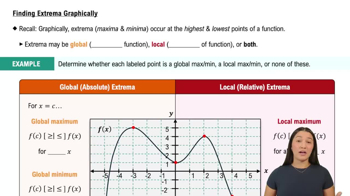Table of contents
- 0. Functions7h 52m
- Introduction to Functions16m
- Piecewise Functions10m
- Properties of Functions9m
- Common Functions1h 8m
- Transformations5m
- Combining Functions27m
- Exponent rules32m
- Exponential Functions28m
- Logarithmic Functions24m
- Properties of Logarithms34m
- Exponential & Logarithmic Equations35m
- Introduction to Trigonometric Functions38m
- Graphs of Trigonometric Functions44m
- Trigonometric Identities47m
- Inverse Trigonometric Functions48m
- 1. Limits and Continuity2h 2m
- 2. Intro to Derivatives1h 33m
- 3. Techniques of Differentiation3h 18m
- 4. Applications of Derivatives2h 38m
- 5. Graphical Applications of Derivatives6h 2m
- 6. Derivatives of Inverse, Exponential, & Logarithmic Functions2h 37m
- 7. Antiderivatives & Indefinite Integrals1h 26m
- 8. Definite Integrals4h 44m
- 9. Graphical Applications of Integrals2h 27m
- 10. Physics Applications of Integrals 2h 22m
5. Graphical Applications of Derivatives
Intro to Extrema
Problem 4.4.14d
Textbook Question
if ƒ(x) = 1 / (3x⁴ + 5) , it can be shown that ƒ'(x) = 12x³ / (3x⁴ + 5)² and ƒ"(x) = 180x² (x² + 1) (x + 1) (x - 1) / (3x⁴ + 5)³ . Use these functions to complete the following steps.
d. Identify the local extreme values and inflection points of ƒ .
 Verified step by step guidance
Verified step by step guidance1
To find the local extreme values, we need to analyze the first derivative, ƒ'(x). Set ƒ'(x) = 0 to find critical points. This involves solving the equation 12x³ / (3x⁴ + 5)² = 0, which simplifies to finding when the numerator, 12x³, is zero.
The critical points occur when 12x³ = 0, which simplifies to x = 0. This is the only critical point since the denominator (3x⁴ + 5)² is never zero.
To determine if x = 0 is a local maximum or minimum, use the second derivative test. Evaluate ƒ''(x) at x = 0. If ƒ''(0) > 0, x = 0 is a local minimum; if ƒ''(0) < 0, x = 0 is a local maximum.
Next, identify the inflection points by setting the second derivative, ƒ''(x), equal to zero. Solve 180x² (x² + 1) (x + 1) (x - 1) / (3x⁴ + 5)³ = 0. This requires finding when the numerator, 180x² (x² + 1) (x + 1) (x - 1), is zero.
The potential inflection points occur when x² = 0, x² + 1 = 0, x + 1 = 0, or x - 1 = 0. Solve these equations to find x = 0, x = -1, and x = 1. Check the sign change of ƒ''(x) around these points to confirm they are inflection points.
 Verified video answer for a similar problem:
Verified video answer for a similar problem:This video solution was recommended by our tutors as helpful for the problem above
Video duration:
8mPlay a video:
Was this helpful?
Key Concepts
Here are the essential concepts you must grasp in order to answer the question correctly.
Local Extreme Values
Local extreme values refer to the points in a function where it reaches a local maximum or minimum. These points occur where the first derivative, ƒ'(x), is equal to zero or undefined. To identify these points, one typically analyzes the sign changes of the first derivative around critical points, which helps determine whether the function is increasing or decreasing.
Recommended video:

Average Value of a Function
Inflection Points
Inflection points are points on the graph of a function where the concavity changes, which can be identified by examining the second derivative, ƒ''(x). Specifically, an inflection point occurs where ƒ''(x) equals zero or is undefined, and the sign of ƒ''(x) changes around that point. This indicates a transition in the curvature of the graph, which is crucial for understanding the function's behavior.
Recommended video:

Critical Points
First and Second Derivatives
The first derivative of a function, ƒ'(x), provides information about the function's rate of change and is essential for finding local extrema. The second derivative, ƒ''(x), offers insights into the function's concavity and helps identify inflection points. Together, these derivatives are fundamental tools in calculus for analyzing the behavior of functions and understanding their graphical representations.
Recommended video:

The Second Derivative Test: Finding Local Extrema

 5:58m
5:58mWatch next
Master Finding Extrema Graphically with a bite sized video explanation from Callie
Start learning





